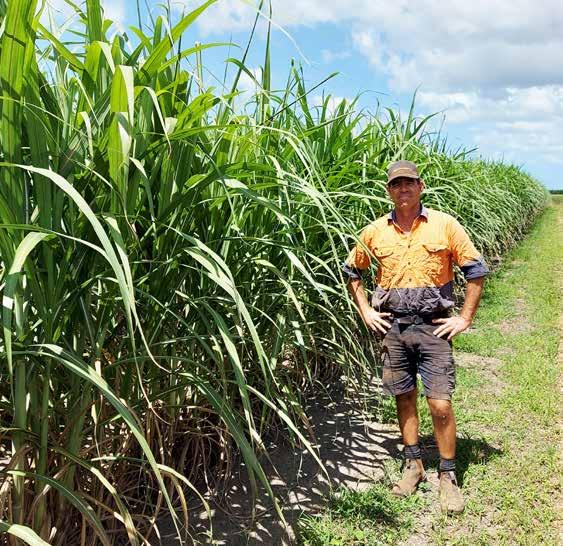
3 minute read
VERY RAPID GERMINATION AND EARLY GROWTH ARE POSITIVES FOR SRA29A
Bruce Peterson says SRA29A shows some positives for growers seeking alternative varieties in the Isis region.
Bruce is a third-generation cane farmer who has been working the family farm since 1992.
Advertisement
His farm at Farnsfield near Childers, which has been in the family since 1964, covers about 170 hectares producing 15,000 tonnes of cane at a CCS of about 14.
Bruce chooses the variety he is going to grow from local knowledge and his own observations.
He is on the Isis Productivity Limited Board and goes to the meetings but also learns a lot “just by chatting to people and keeping up with what’s going on,” he said.
It helps that his farm is one of three approved seed plots in the Isis area for the distribution of clean seed material for old and new varieties, managed by Isis Productivity Limited.
“As far as varieties go, I’ve got my finger on the pulse a bit more than some people are able to, I guess. I grow everything, I had no choice but to grow SRA29 A ,” he said laughing.
A small amount of each variety is received as clean seed stock from SRA Bundaberg and hot water treated for planting out to bulk it up for distribution to the growers the following year.
Each September, growers come to Bruce to collect their varieties. SRA29 A was available for bulk distribution for the first-time in 2022.
“Growers can come and get several tonnes of billets both of new varieties and the old varieties.
“It is a popular service, and we have good uptake. I think we distributed around
476 tonnes of clean seed this season including 242 tonnes of SRA29 A “We mostly supply billets, but some growers take whole stalks.”
SRA29 A has not yet been commercially processed in the Isis district.
Bruce has a couple of hectares of SRA29 A planted on his farm from the distribution.
“I normally plant out large areas of all the varieties. As much as the SRA fact sheets have got all the information, you’ve got to trial it in the real world on your own farm, where your money is invested.
“I’m purely going on observations at this stage: what it’s like to farm and whether it looks any good in comparison with the current standards.
“At this stage there doesn’t seem to be any problems with it.
“It is quite an erect variety. It doesn’t appear to fall over.
“It’s certainly a very fast germinator, one of the quickest I’ve seen in recent years, and a vigorous grower. That’s a plus.
“It does seem to handle dry weather quite well. We run water winches around some of the farm and the bits that have missed out on the water on the ends just seem to hang on a bit more compared with other varieties in the dry conditions. That may make it valuable for a dryland farmer.” Interestingly, the variety drops all its trash when it nears maturity.
“Harvesting should be quite good. It is almost denuded by the time it is ready for harvest. Of course, all the trash sitting on the ground may be a problem in some conditions. We’ll wait to see.
“There are a few varieties that do this pretrashing but I haven’t seen any that do it quite as much as SRA29 A .”
“The millers should receive clean samples into the factory which is good.
“It also makes it easy at billet planting. It cleans up quite well and goes through the machinery quite smoothly.”
The current standard in the district is Q240 A and growers judge how varieties stack up against that.
“Isis Productivity Limited is concerned about the large percentage of Q240 A that is grown but at the same time we realise that growers have got to make the most of what’s on offer.
“Q240 A is an outstanding variety. Sugar prices are high, growers are looking for tonnage and CCS and they are getting it from this variety,” Bruce said.
“One of its stronger points is its ratoonability. Growers are able to get six or seven ratoons from Q240 A which is worth a lot of money.
“It remains to be seen if SRA29 A has got good ratoonability. SRA29 A was evaluated to third ratoon in SRA trials but needs to demonstrate this under commercial conditions.
“I've got small strips to second ratoon in various soil types. It's hard to make a true judgment on that. It’s a bit early. If it has good ratoonability in poor soils, that will be a big plus.
“Almost all my ground is fallowed to peanuts, which leaves the soil in a very healthy state. I also farm on 1.83m row spacings. With these two factors combined, we usually don’t see many issues with ratoons. Soldier fly, a poor variety or a block of very poor soil would usually be the limiting factor in my ratoons.”
Among the unknowns are how SRA29 A will perform with smut.
“Our productivity staff are concerned by quite a significant smut outbreak across the district,” Bruce said.
“We’re looking for varieties that are vigorous and have got positive traits plus smut resistance.
“It has an intermediate rating from SRA, but it still needs to be tested out in the paddock.
“There is also RSD in the district, but I believe it is at low levels due to our clean seed program, the high uptake of clean seed each year and the vigilance of our productivity staff in inspecting plants.
“SRA29 A is yet to be proven I guess. We’ll be watching it closely. We are searching some viable alternatives here.”










